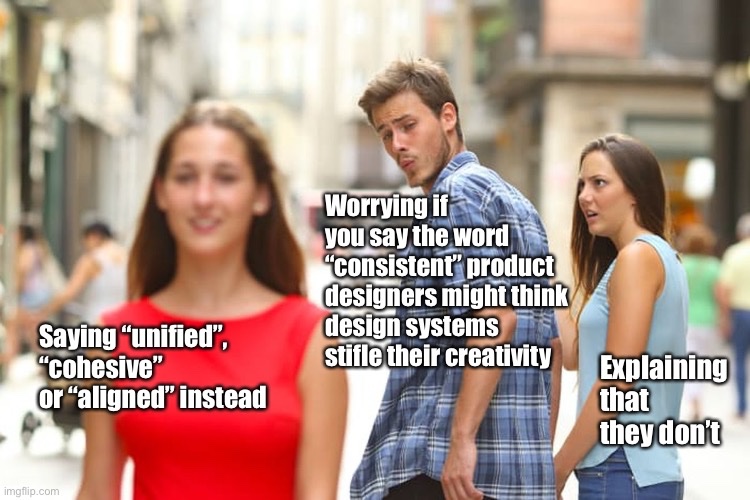Should consistency be a goal of design systems?
It’s becoming increasingly unfashionable to cite “consistency” as a goal for design systems.
I’ve seen plenty of design system teams ditching the term in favour of words like “alignment”, “cohesion” or “unity”.
The goal of swapping these terms around, as far as I can tell, is to combat the perception that those of us building design systems seek to make everything look the same and stifle creative expression.
Personally? I don’t think ditching the word “consistency” is the fix we’re looking for.

Consistency ≠ everything looking the same
One of the UK Government Digital Service (GDS) design principles is “Be consistent, not uniform”.
While GDS advocates using the same language and design patterns to create familiarity, but acknowledges that circumstances vary and context must guide individual design decisions.
Where it’s not possible to follow design and content patterns, GDS advises its designers to “make sure our approach is consistent” - and I think this is an important distinction.
Visual and functional consistency of individual components and design patterns is one version of consistency - but it’s not the only one.
We could instead create a design system that uses a consistent set of primitives and design values, but allows much more flexibility in how they’re applied to individual contexts.
So it’s important that we take the time to consider what level of consistency we’re seeking, and where there’s room for divergence.
No alternative term solves the problem
Taken from Google, here are the (relevant) definitions for the common terms design systems teams use to replace consistency:
- Cohesion is “the action or fact of forming a united whole”
- Alignment is “a position of agreement or alliance”
- Unity is "the state of being united or joined as a whole"
If “consistency” as a term feels too constraining, then perhaps the intent of using these words is to create space through ambiguity.
But that introduces a new problem: a lack of precision. In fact, what they all imply is simply “a system” - a set of things that work coherently as part of something bigger.
Given this, what becomes important is what we mean when we use these terms. And if what we mean is some level of consistency, and that concerns people, then at some point that concern will resurface.
Terminology can’t replace strategy
There might be a design system team who found that switching the word “consistency” for the word “cohesion” allayed all of their stakeholders’ fears, and resulted in universal advocacy - but I’m yet to meet them.
What I often hear instead is that the act of changing the term to something new provided an opportunity to tell a story, to address objections, and to provide clarification. And I suspect these are the things that actually helped.
Design systems always aim to bring an amount of standardisation. It’s by reducing needless and unwanted inconsistency - in approach and in implementation - that they’re able to drive the efficiency that is the bedrock of so many design system investment cases.
How much consistency is desirable, and what we want to standardise, is up for grabs. It has to be discussed and agreed in context, based on what’s right for each individual organisation at a given time.
No one term can convey everything
I see this as an example of a wider tendency in the design systems field. We continually rake over our lexicon in pursuit of the right terms that will perfectly communicate what we mean to convey. When a term creates misconceptions, we’re quick to reach for something else.
But individual terms can only do so much.
In the end, I don’t think it really matters if we say consistency, or cohesion, or alignment, or unity, or anything else. What matters is what we mean, how we qualify it, and how we demonstrate it.
